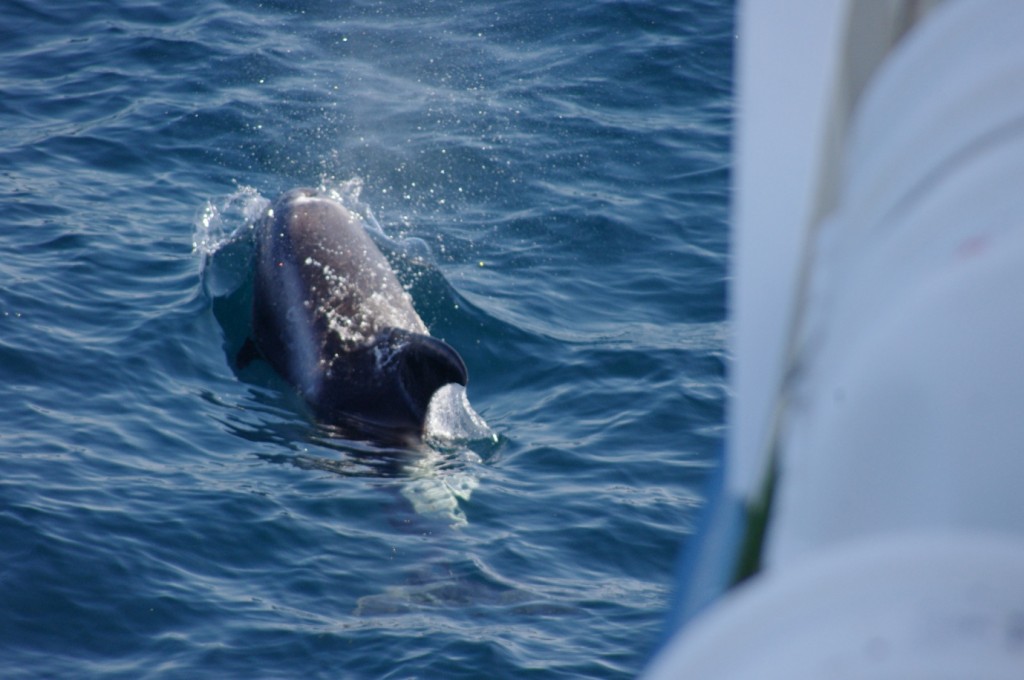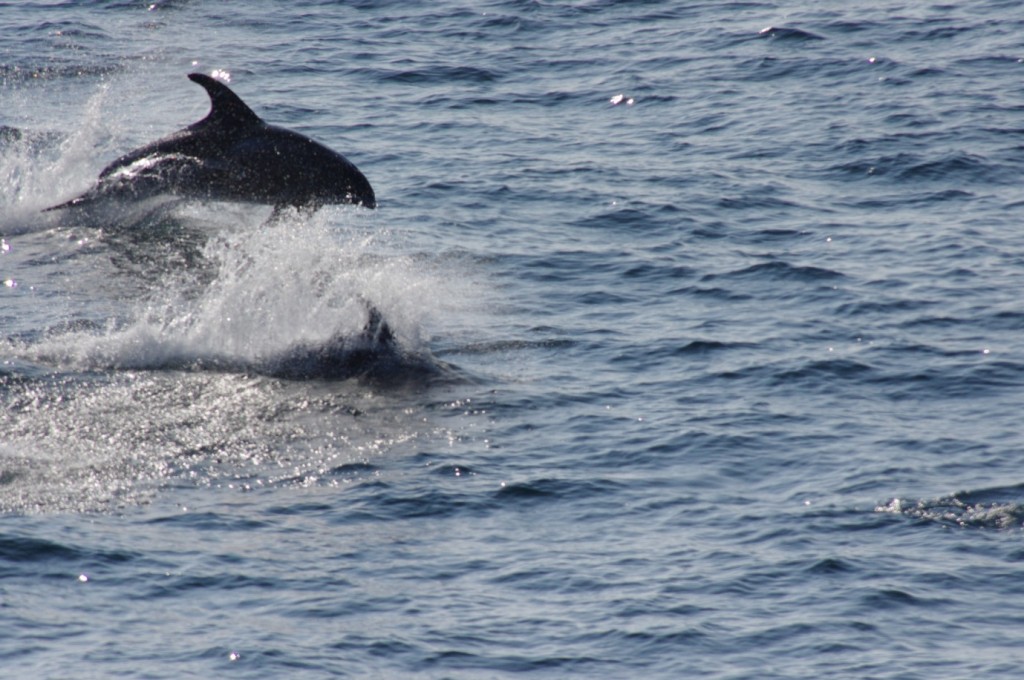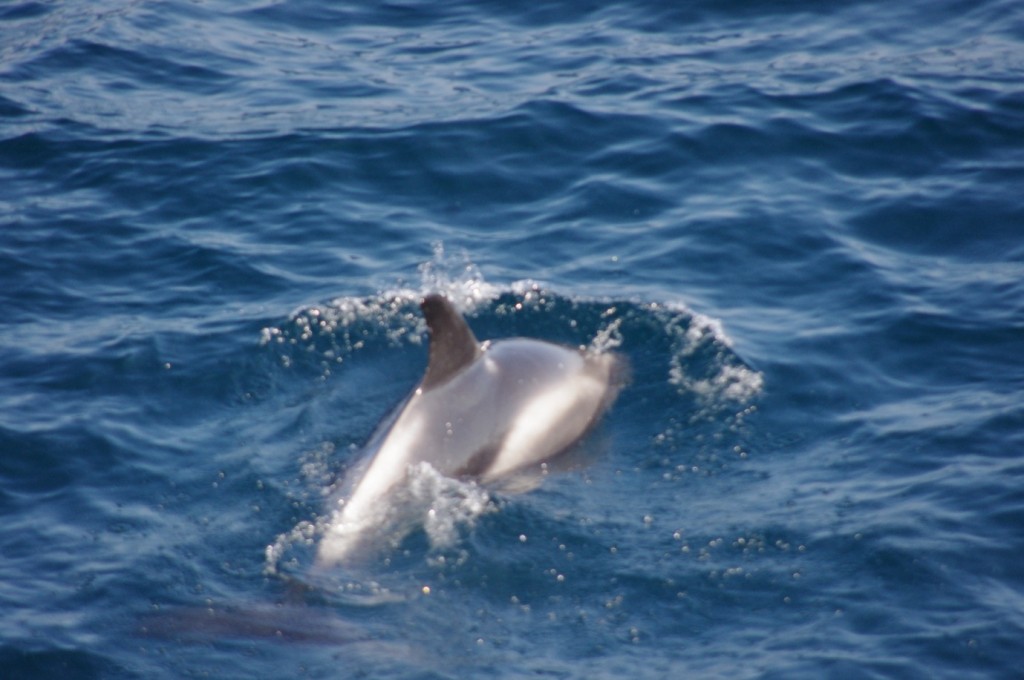During 2016 Sea Watch have had the opportunity to join in with CEFAS surveys on board the Endeavour at various locations around the UK. Using trusted and qualified volunteers, we were able to collect data on six surveys spanning seven to twenty-nine days each. We’d like to thank CEFAS for this valuable opportunity and also our amazing volunteers who found the time in their busy lives to help us collect vital data on the UK’s cetaceans.
A glorious sunny afternoon greeted me when I arrived at Lowestoft on the 7th August. A smiley cheery Scientist in Charge by the name of Ben Hatton also greeted me at the station and we walked to the Endeavour just around the corner. He then kitted me out with a fetching green hard hat to board the boat. My cabin was down in the depths where I had a good surface view of the sea – and any passing dolphins! We returned to land to have one final feast before we set sail late that night.
When I awoke the next morning we were well on our way! I was privileged to be able to take my spotting position up on the bridge – so many electronics, buttons and knobs to press; I was very tempted but thought better of it. The Master, Terry, was so welcoming as were all the crew, they made me feel very much at home. I settled in to my spot excited and expectant to spy cetaceans. Whilst waiting for my first sighting I recorded the sea birds within a 2km range of the boat, aging Gannets and Greater and Lesser Black Backed gulls – a skill I can now say is finely tuned!! No cetaceans were to show themselves on the first day. I did however count over 6 helium balloons ‘floating’ on the sea on the first day. I just hoped there was nothing entangled in the string under the surface…..
The next day or so was a little bumpy and thus my spotting was hampered by the sea state and the state of my unhappy tum. Thankfully Ben and co were very understanding of my predicament and enabled me to rest!
As the week progressed I found my sea legs and numerous sea birds. Seeing my first Great Skua was very exciting as it bullied its way to a free lunch thanks to a poor fulmar. Guillemots and Razor bills were a plenty for a few days. Mixed rafts of them floated by – truly testing my ability to tell them apart at a distance! As the haul of fish was brought on board for the scientists the skies were teaming with gannets of all ages. They are so majestic and powerful as they dive into the waters in hot pursuit of escaping fish. My data sheets for birds were subsequently growing rapidly in number; I had yet to start my cetacean sightings sheet!
As we approached German waters there were vast numbers of cargo vessels and other ships traversing the southern North Sea. The concentration of so many vessels within such a small stretch of sea was eye opening. It provided some insight and understanding as to the dangers that cetaceans face when wild and free. Needless to say I didn’t see any cetaceans in that area!
We then headed north and crossed back to the English coast. Late Thursday afternoon we had to say good bye to one of the scientists. We were just off the coast of Whitby and he was being taken ashore in the rib when, for a fleeting second I glimpsed my first cetacean!!!! A harbour porpoise was making a fast exit port side. My excited squeals of joy at spotting my first cetacean fell on deaf ears as the crew were all absorbed in their tasks. However, I made sure everyone knew my dry spell had been broken once at the dinner table!!
As the second week began the weather became my friend. Calm, flat, mirror still waters provided the best conditions possible for spotting cetaceans. Towards the end of the day I began to spy white water splashes off in the distance. Dolphins fully breaching from the water, five six times in fast succession. My heart leapt too!! This time the squeals were noted and I pointed out to any and everyone who was there what had caused them. As the dolphins travelled nearer I was able to identify them as white beaked dolphins. Later in the evening I saw my first minke whale graciously surfacing 3 times before it dived. This was what it was all about; my patience had finally paid off!!!
The next day the good weather continued and the sea was bubbling with cetaceans. This was to be harbour porpoise day with the odd minke thrown in. Where ever I looked small triangular dorsal fins would be bobbing at the surface. They would be in small pods of 3’s or 4’s, but then larger groups of 8-12. I don’t think they had read the manual. By the end of the day my face was aching due to the smiles. The crew had also got into spotting the harbour porpoise, although they had yet to perfect the squeal!
 Suzie’s first glimpse of white-beaked dolphins from the bridge. Photo by Suzie Miller/ Sea Watch Foundation
Suzie’s first glimpse of white-beaked dolphins from the bridge. Photo by Suzie Miller/ Sea Watch Foundation
I woke the following day to more calm beautiful conditions. We were further north and were definitely in white beaked dolphin territory. Once more it was a plentiful day of sightings! White beaked dolphins and minke whales were to entertain me for the day. I could hardly contain myself when the dolphins deliberately approached the ship and cut across our bow!! If only there was a zip wire from the bridge to the bow, I would have been on it!! The dolphins even hung around long enough for me to attempt to take photos of them – or more realistically of their foot prints! Once again I went to bed a happy girl having had a great day of sightings and the odd encounter with the dolphins
 Breaching white-beaked dolphin. Photo by Suzie Miller/ Sea Watch Foundation
Breaching white-beaked dolphin. Photo by Suzie Miller/ Sea Watch Foundation
The next day was a little less fruitful, no cetaceans were seen sadly. The conditions were still good, low swell, great visibility and fairly calm waters yet the cetaceans did not want to play or I was looking in the wrong direction when they were! However, I did spot a Great Skua and a Balearic Shearwater that day so it wasn’t too disappointing.
 Characteristic white behind the dorsal fin. Photo by Suzie Miller/ Sea Watch Foundation.
Characteristic white behind the dorsal fin. Photo by Suzie Miller/ Sea Watch Foundation.
Sightings started early the next morning! I had just got myself sorted on the bridge when one of the crew spotted 3 white beaked dolphins breaking through the waves as they approached the boat. It was a really good spot as the swell was 1-2 meters and the sea state was of moderate waves of longer foam and spray. So to spot them coming through the breaking waves was quite an achievement! These conditions continued throughout the day, but as the first sighting had proved, if the dolphins were close enough and heading towards the vessel I would be able to spot them so I kept my eyes peeled! I was rewarded twice more for my efforts during the morning! Sadly as the day progressed the weather became a little more energetic and thus I was unable to spot further cetaceans.
For my last day the sea conditions were not very promising at the start of the day. As time went by things started to improve with waters calming and the swell reduced. I had my first sighting of a minke whale mid-afternoon, unfortunately it was one that was only fleeting, but enough to fulfil my daily requirement of seeing a cetaceans!
Sadly that was the end of my travels on the Endeavour as we approached Aberdeen. I am so thankful to all onboard for their encouragement in the dry times but also their patience when maybe the squeals became a little testing….. It was a time of learning in so many areas, but also a time where I was given the opportunity to develop my sea legs – one area that I am still working on!
Massive thanks to all who enabled me to have this opportunity, I loved every minute!
By Suzie Miller, Sea Watch Regional Coordinator for Cumbria
Hear from Hannah, a home-based volunteer, about her CEFAS survey in the North Sea here: www.seawatchfoundation.org.uk/conserving-cetaceans/

























Pingback: Sea Watch Foundation » Irish Sea CEFAS Survey 22nd Sept – 1 Oct 2016